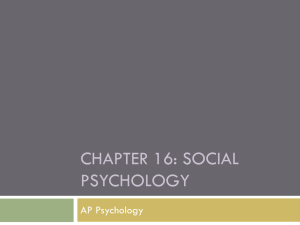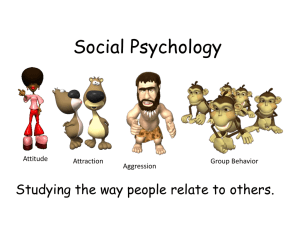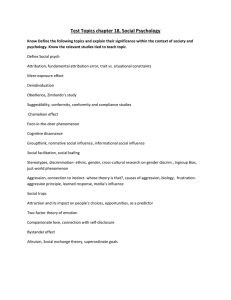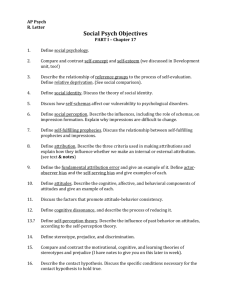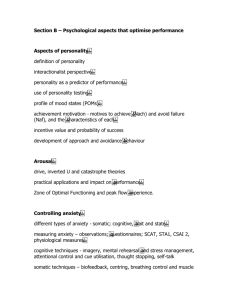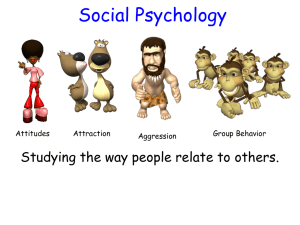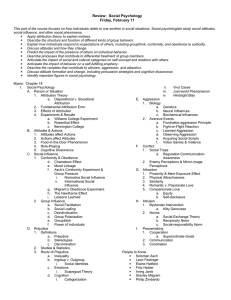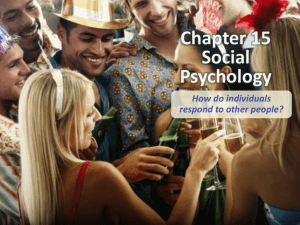Unit-14-Guided-Reading---Social-Psychology
advertisement
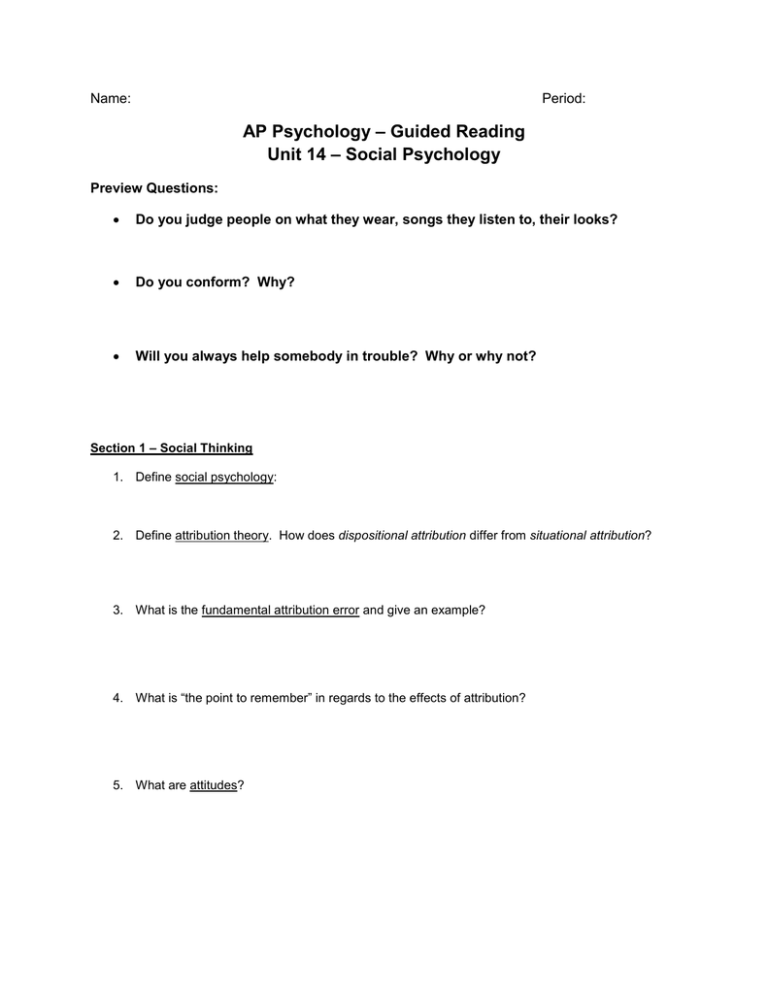
Name: Period: AP Psychology – Guided Reading Unit 14 – Social Psychology Preview Questions: Do you judge people on what they wear, songs they listen to, their looks? Do you conform? Why? Will you always help somebody in trouble? Why or why not? Section 1 – Social Thinking 1. Define social psychology: 2. Define attribution theory. How does dispositional attribution differ from situational attribution? 3. What is the fundamental attribution error and give an example? 4. What is “the point to remember” in regards to the effects of attribution? 5. What are attitudes? 6. How does central route persuasion differ from peripheral route persuasion? a. Given an example of two advertisements, each one using the different types of persuasion. 7. What is the foot-in-the door phenomenon and give an example? 8. Define role, and give an example of how role playing affects attitudes. 9. What is the cognitive dissonance theory and give an example? 10. What is the “heartening implication” of the attitudes-follow-behavior principle? 11. What is the “point to remember” in regards to cognitive dissonance? Section 2 – Social Influence 12. What is the chameleon effect? 13. Why do some people yawn more after seeing others yawn? 14. Define conformity: 15. Summarize Solomon Asch’s experiment. 16. Describe the seven factors that increase conformity. a. b. c. d. e. f. g. 17. What is normative social influence? 18. What is informational social influence? 19. How did Robert Baron “modernize” the Asch experiment? 20. Describe what is meant when the author states our view of social influence as bad or good depends on our values. 21. Describe Stanley Milgram’s experiment dealing with obedience. 22. What was the debate over Milgram’s research ethics? 23. Milgram found that obedience was highest when: a. b. c. d. 24. What do lessons such as Asch’s and Milgram’s experiments demonstrate? 25. What is social facilitation? 26. Explain how the arousal during social facilitation strengthens the most likely response. 27. What is social loafing? Do you do it? Be honest now!! a. Why this social loafing? 28. What is group polarization? 29. What is groupthink? Can you give an example not from the book? 30. What is culture? 31. How does culture affect how a person behaves/thinks? 32. What are norms? Give an example of a norm you follow. 33. Summarize how culture affects various aspects of our lives. 34. What is the difference between social control and personal control? 35. What is minority influence? Section 3 – Social Relations 36. Define prejudice: 37. Define stereotype: 38. Define discriminate: 39. What is the difference between overt prejudice and subtle prejudice? Give examples of each. 40. How can social inequalities lead to prejudice? 41. What are social identities? 42. Who do we reserve our most intense dislike for? Why? 43. What are ingroups? Outgroups? What is an ingroup bias? 44. What is the scapegoat theory? Give an example. 45. What is the other-race effect? 46. What is the just-world phenomenon? 47. What is hindsight bias? 48. What is aggression? 49. What does aggression research show? 50. How does the neural system facilitate aggression? 51. High testosterone correlates into: 52. Describe how the “traffic” between hormones and behavior is two-way. 53. How does alcohol influence aggression? 54. What is the frustration-aggression principle? 55. How can ostracism lead to aggression? 56. What is the influence of minimal father care? 57. What does research show about observing models of aggression? 58. What are social scripts? Give an example. 59. What do some recent studies show about the influence of video games on aggression? What is your opinion? 60. Why is proximity so conducive to liking? a. What is the mere exposure effect? 61. What most affects your first impressions (after proximity)? 62. Physical attractiveness also predicts: 63. What two findings might “reassure Cicero”? a. b. 64. What aspects of attractiveness are cross-cultural? 65. How does similarity influence attraction? 66. What is the reward theory of attraction? 67. What is passionate love? a. List two theoretical assumptions about passionate love. 1. 2. 68. What is companionate love? 69. What can be a long term problem with passionate love? 70. Define equity and list some examples. 71. What is self-disclosure and how can it strengthen a relationship? 72. What is altruism? 73. What is diffusion of responsibility? 74. What is the bystander effect? 75. The best odds of helping someone occurs when: a. b. c. d. e. f. g. h. 76. What is the social exchange theory? 77. Describe the reciprocity norm? 78. What is the social-responsibility norm? 79. According to social psychologists, what is conflict? 80. What are social traps? 81. What do social traps challenge us to do? 82. What are mirror-image perceptions? 83. What are self-fulfilling prophecies? 84. Describe how the following four concepts can help make peace. a. Contact – b. Cooperation – c. Communication – d. Conciliation – Review: What parts of the chapter do you find most interesting? Why? List 3 questions you have or things you want to know more about.
